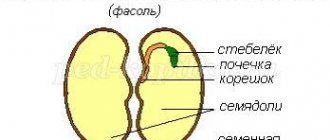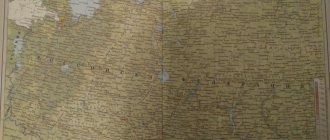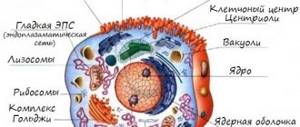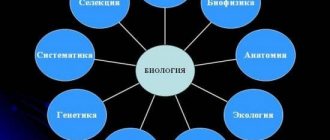Download material
so UNT / Lesson developments / Biology lessons
Abstract for the biology lesson “Main human tissues: epithelial, connective, muscle, nervous” 8th grade
10/08/2015 5534 669 Gladkova Elena Nikolaevna Purpose of the lesson: to form knowledge among schoolchildren about the main human tissues. Lesson objectives: 1. expand the concept of fabrics; form an idea of the structure and functions of epithelial, connective, muscle and nervous tissues, reveal the connection between structure and function using the example of these tissues; 2. improve skills in working with a microscope, continue to develop the ability to reason, systematize the information received, tell stories based on drawings, draw conclusions independently; 3. cultivate a caring attitude towards your body. Equipment: table “Tissues”, microscopes, microslides “Epithelial tissue”, “Types of connective tissue”, “Muscle tissue”, “Nervous tissue”, Lesson type: lesson in the formation of new knowledge Lesson progress I. Organizational moment. II. Setting goals and objectives. III. Updating basic knowledge. Test. 1 - Task 1. The cell nucleus contains: A) nuclear sap B) cytoplasm C) lysosomes D) mitochondria E) ER F) cell membrane. 2. The function of mitochondria is: A) protein synthesis B) oxidation of organic substances C) lipid synthesis D) synthesis of organic substances E) starch synthesis 3. Protein synthesis occurs in A) cytoplasm B) lysosomes C) vacuoles D) ribosomes E) smooth EPS 4. The cells of the human body contain: A) 48 chromosomes B) 46 chromosomes C) 44 chromosomes D) 23 chromosomes; E) 22 chromosomes 5. The “digestive” function is characteristic of A) the nucleus B) mitochondria C) lysosomes D) EPS E) membranes 6. The main role of DNA in the cell is: A) formation of the cell membrane B) accumulation of nutrients C) formation proteins D) storage and transmission of hereditary characteristics; E) cell protection. 7. Enzymes are: A) proteins that slow down chemical reactions in the cell B) nucleic acids that accelerate chemical reactions in the cell C) carbohydrates that accelerate chemical reactions in the cell D) lipids that accelerate chemical reactions in the cell E) proteins that accelerate chemical reactions in the cell 8. The science of the cell is A) cytology B) biology C) histology D) anatomy E) hygiene 9. The ability of a cell to respond to environmental changes is: A) growth B) reproduction C) irritability D) development E) respiration 10. There are smooth and granular (rough): A) lysosomes B) ER C) nucleus D) mitochondria E) cytoplasm Answer codes: 1 – A 2- B 3 – D 4- B 5 – C 6 – D 7 – E 8 – A 9 – C 10 – B 2 -Task Rewrite the text, inserting the missing words: The main parts of any cell are ... and .... In the core there are thread-like formations - .... The cell is covered... The cytoplasm contains the smallest structures -.... . ... are called the “powerhouses” of the cell. Proteins are formed in... The endoplasmic reticulum can be... and.... Cell organelles also include...,....... (Answers: cytoplasm, nucleus, chromosomes, membrane, organelles, mitochondria, ribosomes, smooth, rough, lysosomes. Golgi complex, cell center). Peer review. Grading scale: “5” - no errors “4” - 1-3 errors “3” - 4-6 errors “2” - more than 6 errors Learning new material. A). Characteristics of fabrics. What is the science of tissue called? (histology). Remember the definition of “fabric”? Tissue is a group of cells and intercellular substance, united by a common structure, function and origin (write in a notebook). In the human body, there are four groups of main tissues: epithelial, connective, muscle and nervous. In muscles, for example, muscle tissue predominates, but along with it there is also connective and nervous tissue. The intercellular substance can also be homogeneous, like that of cartilage, or it can include various structural formations in the form of elastic bands and threads that give elasticity and firmness to the tissues. Fill out the table “Tissue Features” Tissues Varieties Functions Structural Features Location Epithelial Single-layer, multilayer, glandular, ciliated Protective, secretory, absorptive cells closely adjacent to each other, forming a layer, there is very little intercellular substance; cells have the ability to restore (regenerate) Organ membranes, endocrine glands, integument of the body Connective Bone
Cartilaginous
Blood
Adipose tissue
Elastic connective tissue Supporting, protective, hematopoietic Supporting, protective Respiratory, transport, protective
Storage, protective
Supportive-protective They have a diverse structure, but are similar in the large amount of intercellular substance that determines the mechanical properties of tissues Skeleton
Respiratory organs, auricle, ligaments
Cavity of the heart and blood vessels Subcutaneous tissue, between internal organs
Ligaments, tendons, layers between organs, dermis Muscular Smooth,
Striated,
Cardiac Contractile
Contractive
Contractile spindle cells with one rod-shaped nucleus
Long multi-core fibers
Muscle fibers connected to each other, having a small number of nuclei in the center of the fiber Muscles of the digestive tract, bladder, lymphatic and blood vessels, and other internal organs
Musculoskeletal system of the body and some internal organs
Heart Nervous Ensuring the coordinated activity of various organ systems, ensuring the connection of the body with the external environment, adapting metabolism to changing conditions Includes two types of cells - neurons and neuroglia Brain and spinal cord, nerve ganglia and fibers Groups of tissues of the human body Group of tissues Types of tissues Structure of tissue Location Functions Squamous epithelium
Glandular
Ciliated (eyelash)
The surface of the cells is smooth. The cells are tightly adjacent to each other.
Single layer. Pokrovny. Glandular cells that produce secretions.
Single layer. Glandular. Consists of cells with numerous hairs (cilia). Single layer. Pokrovny. Skin surface, oral cavity, esophagus, alveoli, nephron capsules, pleura, peritoneum.
Skin glands, stomach, intestines, endocrine glands, salivary glands.
Respiratory tract, spinal canal, ventricles of the brain, oviducts
Integumentary, protective, excretory (gas exchange, urine excretion).
Excretory (secretion of sweat, tears), secretory (formation of saliva, gastric and intestinal juices, hormones).
Protective (cilia retain and remove dust particles), organize fluid flow and movement of the egg. Reabsorption during the formation of secondary urine, secretion of saliva, secretions with hormones. The mucous membrane of the stomach and intestines. Protective, covering, thermoregulating. Stretches in organs that change their volume. Nervous Nerve cells (neurons)
Neuroglia The bodies of neurons are varied in shape and size, up to 0.1 mm in diameter.
Short processes of neurons are tree-like branching dendrites. Long processes of neurons are dendrons more than 1 m long. Nerve fibers - axons (neurites) - long outgrowths of neurons up to 1 m in length. In organs they end with branched nerve endings.
Neuroglia consists of neurocyte cells. They form the gray matter of the brain and spinal cord. They connect with processes of neighboring cells. The receptors are connected to the body of the sensory neuron via the centripetal nerve. Nerves of the peripheral nervous system that innervate all organs of the body. Located between neurons. GNI. Communication of the organism with the external environment. Centers of conditioned and unconditioned reflexes. Nervous tissue has the properties of excitability and conductivity.
They transmit the excitation of one neuron to another, establishing a connection between all organs of the body.
Transmits excitation from receptors along sensitive neurons to the nerve cell (neuron body) Conducting pathways of the nervous system. They transmit excitation from the nerve cell to the periphery via centrifugal neurons.
Support, protection, nutrition of neurons.
Connective Dense fibrous Loose fibrous Cartilaginous (hyaline, elastic fibrous) Bone compact and spongy
Blood and lymph Groups of densely lying fibers consisting of collagen protein, almost without intercellular substance
Loosely arranged fibers and cells intertwined with each other. The intercellular substance is structureless, with mast and fat cells.
Living round or oval cells, chondrocytes, lying in capsules.
Living cells are osteocytes with long processes connected to each other. Collagen fibers. Intercellular substance - inorganic salts of calcium and phosphorus, ossein protein.
Liquid connective tissue. It consists of formed elements and plasma (liquid with organic and mineral substances dissolved in it). The skin itself, tendons, ligaments, membranes of blood vessels, cornea of the eye
Subcutaneous fatty tissue, pericardial sac, nervous system pathways, blood vessels, mesenteries.
Intervertebral discs, cartilage, larynx, trachea, ribs, auricle, surface of joints, bases of tendons, fetal skeleton.
Skeletal bones.
Circulatory and lymphatic systems of the whole body. Integumentary, protective, motor.
Connects skin to muscles, supports organs in the body, fills gaps between organs. Participates in body thermoregulation.
Smoothes the rubbing surfaces of bones. Protection against deformation of the respiratory tract and ears. Attachment of tendons to bones.
Supportive, protective, motor, hematopoietic.
Carries oxygen and nutrients throughout the body. Collects carbon dioxide and dissimilation products. Ensures the constancy of the internal environment, chemical and gas composition of the body. Protective (immunity – production of antibodies). Regulatory (humoral – carries hormones). Muscle Cross-striped Multinuclear fibers of a cylindrical shape up to 10 cm long, striated with transverse stripes (filaments of actin and myosin). Skeletal muscles, cardiac muscle (the fibers of this muscle are connected by intercalary discs) Has the properties of excitability and contractility. Voluntary movements of the body and its parts, facial expressions, speech (controlled by the somatic nervous system). Involuntary contractions (automatic) of the heart muscle to push blood through the chambers of the heart (this muscle is controlled by the autonomic nervous system). Smooth Mononuclear cells with pointed ends up to 0.5 mm long Walls of the digestive tract, blood and lymph vessels, skin muscles. It has the properties of excitability and contractility. Involuntary contractions of the walls of internal hollow organs. Raising hair on the skin. Controlled by the autonomic nervous system. Reinforcement: 1. Histology is the science of tissues. 2. Tissue - a group of cells and intercellular substance, united by a common structure, function and origin. 3. Epithelial tissue - cells fit tightly to each other, there is little intercellular substance. Types: glandular, single-layer, multi-layer, ciliated (ciliary). Functions: protective, suction, secretory. 4. Connective tissue - the cells are loosely located, the intercellular substance is highly developed. Types: bone, cartilage, fat, blood, fibrous. Functions: supporting, protective, hematopoietic, storage, respiratory, transport. 5. Muscle tissue - formed by muscle fibers, capable of excitation and contraction. Types: striated (skeletal and cardiac) and smooth. Function: contractile. 6. Nervous tissue - consists of cells with processes. Capable of being excited and transmitting excitement. 7. What is fabric? 8. How many types of tissues are there in the human body? Name them. 9. What types of connective tissue do you know?
See the downloadable file for the full text of the material.
The page contains only a fragment of the material.
Basic notes on biology grade 8.
There are no uneducable children; there are unprofessional teachers. Going from the whole to the part, relying not on rote learning, but on understanding - this is the basis of Shatalov’s method. Studying can be compared to looking at a painting. If you break the canvas into pieces and take them separately, then it is unknown whether a holistic perception of the image will emerge. But this is how they usually teach in school. And if you first give an idea of the whole, then the pieces will easily fall into place and the mosaic will be complete. Shatalov provides solid knowledge through skillful structuring of the material, building up information at an optimal pace and repeating it many times. Neglect of proportion in dosing educational material leads to the fact that “it flies into one ear and flies out of the other.” The problem is not solved by improving the examination system, but by teaching methods that enhance the natural mechanism of understanding. How many times must the material be repeated before the child can understand and reproduce it? Shatalov tells as much as necessary, and in different versions. For the first time in world teaching practice, he created a system that effectively ensures the operation of the “mechanism” for understanding the text, thereby obtaining a huge gain both in time and in the quality of learning the educational material.
Where does this miracle come from?
Already the first experimental class completed the school course two years ahead of the program, all 33 students became university students, 17 of them received increased scholarships. From the seemingly hopeless students (the experimenter was assigned to classes “G” and “D”), 61 candidates of sciences and 12 doctors graduated. Donetsk was a pedagogical Mecca. Followers work successfully all over the world. Lyudmila Moskalina, a former Moscow teacher, is in Chicago, Li Yigao is in Beijing, Voltaire Chanturia is in Batumi, etc. During the period of perestroika, Shatalov was crowned with titles and... tried to be forgotten. There were more important things to do, and it was awkward in front of the West. There they switch from 11 years of study to 12, and our eccentric - from 10 years to 9, then 8 and 7. With the collapse of the Union, the experiment was stopped. Shatalov, meanwhile, improved his system. In his eighth decade of life, he traveled around the CIS and taught children. I once taught a yearlong geometry course in a children’s colony in 3.5 hours (30 minutes a day). The examiners began to cry; they had never heard such perfect answers in math classes. The ascetic was awarded the Order of St. Nicholas the Wonderworker, the Soros Prize, was elected Honorary President of the Italian Dante Alighieri Association, and his books were published in 17 countries. “Where does such a miracle come from?” - moms ask. Grandmothers don't ask questions. They remember Shatalov from programs from Ostankino, from newspaper publications, and films. S.L. Soloveichik’s play about Shatalov was shown at the Youth Theater for more than ten years. Even grandmothers from Tel Aviv, New York, Riga buy all the books and video lessons on the Internet, and take their grandchildren to study not in London, but in Moscow. Shatalov's system is not a fairy tale. However, the press and television still remember him.
Based on materials from the publication “Shatalov System. Annual course - In 10 hours!” Candidate of Philosophical Sciences S. Vinogradov. Magazine “Science and Life” No. 2, 2008.
Biology lesson on the topic "Tissues", 8th grade
8th grade students study biology at a basic level. There are 8 boys and 12 girls in the class, including one student with disabilities. Average age 14 years. Based on the results of the 1st half of the year, the grades in biology were: “5” - 4 people, “4” - 8 people, “3” - 8 people.The children in this class are interested in good knowledge of biology, some of them suggest further studies at universities in the relevant field. In general, students in the class have positive learning motivation, both in the learning process and in the final goal of learning. However, students have different levels of development of mental personality traits. Conventionally, three groups can be distinguished: high, medium and medium-low levels of development.
4 people have a high level of intelligence development. They have steady attention and can quickly switch when necessary. Well-developed skills to analyze, compare, generalize, classify, and establish logical connections. The guys in this group have developed monologue speech, they know how to operate in biological terms, they are efficient, purposeful, and they know how to defend their point of view. They are able to transfer knowledge from one phenomenon to another, and are ready to perform creative tasks as well as research tasks. They are capable of self-control and adequate self-esteem. They work actively in class.
Another group of 9 people of the so-called average level. These students also have educational motivation, but the level of mental development differs from the level of representatives of the first group. Reproductive modes of action predominate in them; they can perform tasks well according to the specified algorithm, but find it difficult to establish cause-and-effect relationships. These students turn to the teacher or “strong” classmates for help. When working in a multi-level group, they act as a “follower”.
At the same time, there is a group of 8 people in the class with a medium-low level of development. These students have difficulty learning the material. Performance in class is low and they get tired quickly. They can carry out tasks according to a model, plan or algorithm, but are not able to cope with a creative task. Constantly need help and control.
Mutual assistance is well established in the class, so during lessons you can use a form of work such as work in multi-level groups. Taking into account the motivation of the class and its readiness to perceive, it is advisable to use the method of problematic presentation of educational material, search and research methods, as well as AMO methods and cooperation technology.







